Kuli South Georgia Expedition
Oct 15
#5: AUSCHWITZ FOR WHALES
Published at 17:43
King Edward Point, the only human settlement on South Georgia, is a place
where the bounty of nature meets horror flick.
On one side of King Edward, elephant seals nurse their newborn pups,
penguins pose for tourists, fur seals frolic in the tide beneath mountain
peaks that rival the best of the Swiss Alps. On the other side, stand the
rusting remnants of what was once a blood-drenched killing floor – the
Grytviken whale-processing station. The contrast of pristine habitat and
decaying death machine is almost comical.
Grytviken’s graveyard-quiet infrastructure – the Rust Belt of South
Georgia – is a memorial to an industry that employed some 1,000 men at its
height. Starting in 1904, hunters from Norway, Scotland and even Japan
sailed to the southern ocean, harpooned the unsuspecting cetaceans and towed
their carcasses to Grytviken. Once ashore, men known as flensers ripped
their bellies open with long knives and gutted them. The dead whales were
then drawn up a ramp and put through an industrial processing line. Their
body oils were turned into lamp fuel; their blubber became dog food; their
bones were used for everything from scrimshaw to lining for women’s
dresses.
Paul Mayewski dubbed the site “Auschwitz for Whales.” A more fitting
nickname has rarely been coined.
By the mid-20th Century, whale populations were so sparse that they could no
longer be hunted profitably. Grytviken shut down in 1965. But the shores of
King Edward are lined with whale vertebrae the size of flat-screen TVs to
this very day.
The history of South Georgia’s whaling industry is documented in the
Grytviken museum, managed by the wonderfully witty Sarah Lurcock. She and
her husband, Pat, has lived on South Georgia for nearly 20 years. Their home
is on the beachfront, with broad bay windows that look out on fairytale
landscapes – away from the whale processing plant.
Across the bay lies a cemetery for fallen whalers, most of whom have
Scandinavian names. But the most famous resident here is Sir Ernest
Shackleton, the Anglo-Irish explorer who quite nearly became the first
person to set foot on the South Pole. In 1916, he and his crew were
shipwrecked off the coast of Antarctica. Shackleton sailed 800 miles from
Antarctica to South Georgia in an open lifeboat to save his men – and
succeeded. Death came from a heart attack while he was moored off South
Georgia in 1922. It became Shackleton’s final resting place.
Everyone is anxious for the science portion of this journey to get under
way. But a three-day storm is heading straight for us. Ice cores – the
objects of Mayewski’s desire, and the entire reason we came here –
remain tantalizingly out of reach.
where the bounty of nature meets horror flick.
On one side of King Edward, elephant seals nurse their newborn pups,
penguins pose for tourists, fur seals frolic in the tide beneath mountain
peaks that rival the best of the Swiss Alps. On the other side, stand the
rusting remnants of what was once a blood-drenched killing floor – the
Grytviken whale-processing station. The contrast of pristine habitat and
decaying death machine is almost comical.
Grytviken’s graveyard-quiet infrastructure – the Rust Belt of South
Georgia – is a memorial to an industry that employed some 1,000 men at its
height. Starting in 1904, hunters from Norway, Scotland and even Japan
sailed to the southern ocean, harpooned the unsuspecting cetaceans and towed
their carcasses to Grytviken. Once ashore, men known as flensers ripped
their bellies open with long knives and gutted them. The dead whales were
then drawn up a ramp and put through an industrial processing line. Their
body oils were turned into lamp fuel; their blubber became dog food; their
bones were used for everything from scrimshaw to lining for women’s
dresses.
Paul Mayewski dubbed the site “Auschwitz for Whales.” A more fitting
nickname has rarely been coined.
By the mid-20th Century, whale populations were so sparse that they could no
longer be hunted profitably. Grytviken shut down in 1965. But the shores of
King Edward are lined with whale vertebrae the size of flat-screen TVs to
this very day.
The history of South Georgia’s whaling industry is documented in the
Grytviken museum, managed by the wonderfully witty Sarah Lurcock. She and
her husband, Pat, has lived on South Georgia for nearly 20 years. Their home
is on the beachfront, with broad bay windows that look out on fairytale
landscapes – away from the whale processing plant.
Across the bay lies a cemetery for fallen whalers, most of whom have
Scandinavian names. But the most famous resident here is Sir Ernest
Shackleton, the Anglo-Irish explorer who quite nearly became the first
person to set foot on the South Pole. In 1916, he and his crew were
shipwrecked off the coast of Antarctica. Shackleton sailed 800 miles from
Antarctica to South Georgia in an open lifeboat to save his men – and
succeeded. Death came from a heart attack while he was moored off South
Georgia in 1922. It became Shackleton’s final resting place.
Everyone is anxious for the science portion of this journey to get under
way. But a three-day storm is heading straight for us. Ice cores – the
objects of Mayewski’s desire, and the entire reason we came here –
remain tantalizingly out of reach.
- Name: King Edward Point / Grytviken
- Elevation: 0 m
- Latitude: 54° 16’ 54” South
- Longitude: 36° 30’ 28” West

Norwegian Lutheran Church at Grytviken, built in 1913. The pastor, Kristen Loken, left in 1931, complaining that the whalers' religious lives "left much to be desired."





















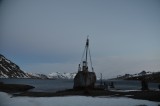
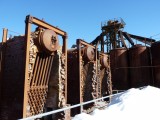
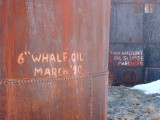


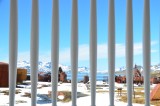
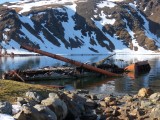

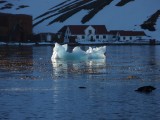

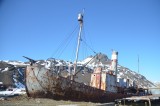
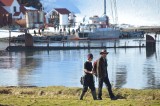
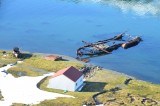
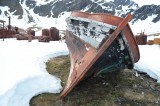
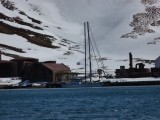
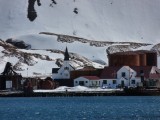

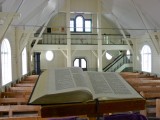







Comments